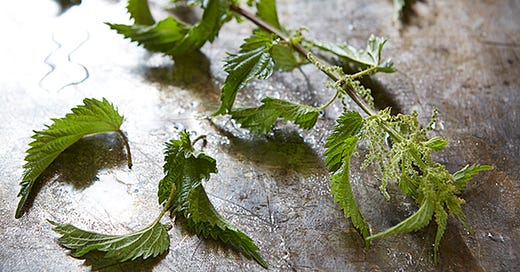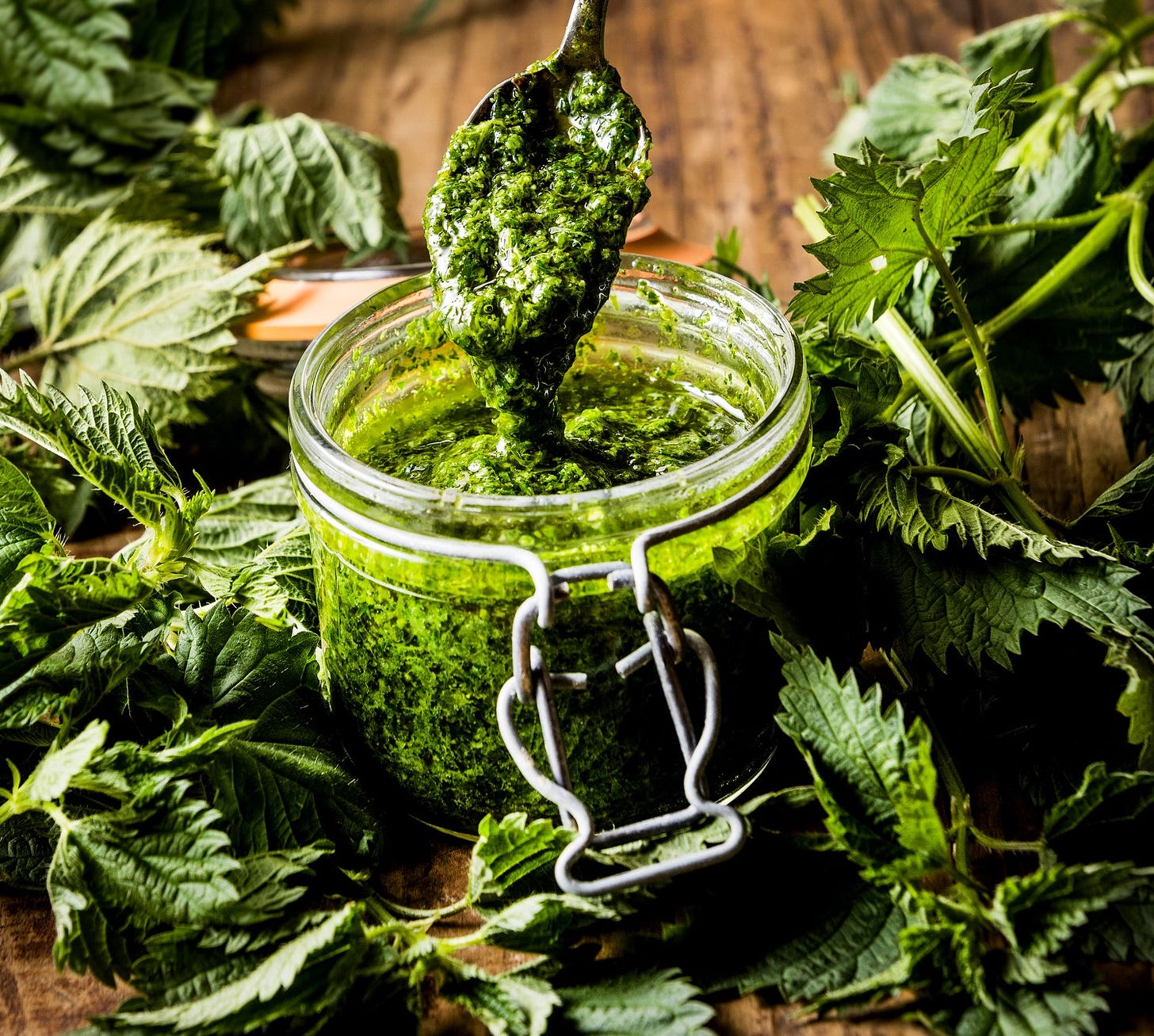“Wild is about Nature going about its own business without much human intervention.” Poet and Environmentalist Gary Snyder
Besides my Grandmother who taught me how to forage wild plants such as lambs quarters (also known as goosefoot or pig weed), wild asparagus, purslane, huckleberries, and to catch trout with my hands, there are two notable wild foragers and their books who furthered my education: Billy Joe Tatum’s book Billy Joe Tatum's Wild Foods Field Guide and Cookbook, and Euell Gibbon’s three books: Stalking the Wild Asparagus, Stalking the Blue-Eyed Scallop and Stalking the Healthful Herbs. One other book that has been a very useful resource for me over the years is the L. L. Bean Game & Fish Cookbook by Angus Cameron and Judith Jones. The books by Samuel Thayer The Forager’s Harvest and Nature’s Garden should also be part of your library since they do such a good job of describing wild edible plants.
Our prehistoric ancestors picked and gathered wild plants that were, in many ways, far more healthful than the stuff we buy today at farmers' markets. This isn't the result of the much-bemoaned modern, industrial food system. It has been thousands of years in the making ever since humans first took up farming (some 12,000 years ago, more or less) and decided to cultivate the wild plants that were the most pleasurable to eat. More pleasurable generally meant less bitter and higher in sugar, starch or oil.
We looked around at all these wild plants that we had been eating for millennia and we kind of said to each other, “We're getting tired of eating this bitter, chewy, fibrous, low-sugar food.”
Over the centuries those choices in human agriculture led to a dramatic loss in the nutrient value of the plants we eat most commonly — something we had no way of knowing until recently, when modern technology made it possible to do so.
STINGING NETTLES
Despite the sting of their prickly leaves, stinging nettles are secretly both good tasting and good for you. The sting comes from formic acid in the hairy leaves, which is neutralized when cooked. Nettles are greens with amazing culinary and medicinal properties. They are high in iron, potassium, manganese, calcium and Vitamins A and C and are also a decent source of protein.
The word "nettle" describes more than 40 different flowering plant species from the Urtica genus, which comes from the Latin word "uro," meaning, "I burn." The plant is native to Europe, Asia, Africa and North America, and is found wild throughout the continental United States. Nettles are readily available in spring and early summer.
Look for young plants in spring and summer when you are ready to forage. Always pick the leaves while wearing thick gloves and a long-sleeved shirt (and pants). When foraging, only pick the nettle tops (the top four leaves) and make sure the nettles are less than knee-high. Nettles are found in woodsy areas and forests, in natural grasslands, along fertile fields and riverbanks, and along shaded trails.
To cook nettles, wash and drain, discarding the stems. Place the leaves in a pot of boiling salted water and cook for 1 to 2 minutes until nettles are wilted. Drain through a colander and press out any excess water. Nettles can be stored in an airtight container in the refrigerator for up to 5 days. Again, after cooking, nettles produce an entirely sting-free eating experience.
STINGING NETTLE AND GOAT CHEESE QUICHE
Serves 6
You can also combine nettles with lamb’s quarters or any other leafy green like spinach for this quiche.
12 ounces washed fresh young stinging nettles, tough stems discarded
2 large eggs
2 large egg yolks
1-1/2 cups heavy cream
Kosher salt and freshly ground black pepper
1/2 cup finely crumbled goat cheese, such as Bucheron
3 tablespoons finely chopped green onions
1 tablespoon chopped fresh tarragon
1/8 teaspoon freshly grated nutmeg
1/3 cup freshly grated Parmigiano-Reggiano
1 partially baked tart shell in a 10-inch removable bottom tart pan (recipe follows)
Blanch the nettles in boiling salted water for 20 seconds or so then drain. Make sure the nettles are tender. If you are using older nettles you may need to cook them longer. Plunge the nettles into cold water and drain again. Put the nettles in a clean kitchen towel and squeeze out as much of the moisture as you can. You should have a ball measuring about 3/4 cup. Chop well and set aside.
In a bowl, combine the eggs, yolks, and heavy cream. Season the mixture with salt and pepper and whisk until thoroughly blended. Whisk in the goat cheese, green onions, tarragon, nutmeg, Parmigiano, and chopped nettles.
Heat the oven to 375°F. Put the prebaked tart on a baking sheet with sides in case there is any leakage. Pour the egg and nettle custard into the tart shell, being careful that it doesn’t overflow. Bake until the filling is nicely puffed and browned, 40 to 50 minutes. Let cool for at least 15 to 20 minutes before serving.
All-butter pie crust:
Makes one 9 inch pie crust
Recipe can be doubled for a double crust; divide dough into two balls and form two disks before chilling.
1-1/4 cups all-purpose flour
1/4 teaspoon salt
10 tablespoons unsalted butter, chilled and cut into 1/2-inch pieces
3 to 5 tablespoons ice water.
In a food processor, briefly pulse together the flour and salt. Add the butter and pulse until mixture forms pea-size pieces (3 to 5 one-second pulses). Add ice water 1 tablespoon at a time, and pulse until mixture is just moist enough to hold together.
Form the dough into a ball, wrap with plastic and flatten into a disk. Refrigerate at least 1 hour before rolling out and baking.
For the prebaked rust: Preheat oven to 375°F. On a lightly floured surface, roll out the pie crust to a 12-inch circle. Transfer the crust to a 9-inch pie plate. Fold over any excess dough, then crimp the edges. Prick crust all over with a fork. If you have time, freeze the crust for 15 to 30 minutes to relax the gluten. Cover pie with aluminum foil and fill with pie weights (you can use pennies, rice or dried beans for this). Bake for 15 minutes. Remove the foil and weights, and bake until pale golden, 5 to 7 minutes more. Cool on rack, and it’s ready to fill.
NETTLE PESTO
Makes 1-1/2 cups
Delicious with pasta, but also try adding nettles as a garnish for creamy soups, and fold into softened butter for a delicious topping for meats, fishes and vegetables.
5 cups or so uncooked nettles leaves and small stems
3 cloves garlic
4 tablespoons pine nuts or blanched almonds, lightly toasted
1/2 cup extra-virgin olive oil, plus more as needed
1/2 cup or so freshly grated Parmesan cheese
2 teaspoons finely grated lemon zest
Salt and pepper to taste
With tongs, place the nettles and garlic in a big pot of salted, boiling water for 1 to 2 minutes. Drain and immediately plunge into cold water to stop the cooking and to set the color. Drain again and wring dry in a clean tea towel. Coarsely chop both the nettles and garlic. You should have 1-1/4 cups or so.
In a food processor or blender, combine the nettles, garlic, pine nuts, olive oil, cheese and zest. Process in bursts to chop coarsely until a thick green sauce forms. The mixture can be as smooth or textured as you prefer. If the sauce is too thick, add a little more olive oil. Season to your taste with salt and pepper.
Pour into a glass jar or other container and top with a thin layer of olive oil to prevent the surface from discoloring. Cover tightly and refrigerate for up to 1 week or frozen for up to 3 months.
John Ash 2025





